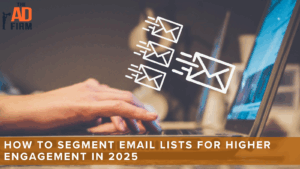In the competitive digital marketing landscape, advanced pay-per-click (PPC) advertising tactics are crucial to goals beyond boosting your online visibility. With the right strategies and techniques, you can optimize your ads to generate revenue and be more cost-effective.
Because while running digital ads sounds straightforward enough, it gets trickier when you’re shelling out cash without seeing returns. It’s not a situation you’d want to find yourself in. When this happens, it only means that you must explore nuanced approaches to PPC strategies that involve constant monitoring, iterations, and analysis, among other things.
This article will explore these approaches and share what we’ve learned about advanced PPC management tactics that effectively enhance campaign performance.
Advanced PPC Tactics for Boosting Campaign Performance
When you employ advanced PPC tactics, your goal shifts from simply investing so you earn more impressions, clicks, traffic, or even conversions. With these approaches, you achieve those goals — enhancing returns while lowering ad costs.
READ ALSO: 5 Signs Your Digital Marketing Strategy Needs a Revamp
Now, let’s revisit some critical aspects of running paid digital advertising campaigns and introduce you to some techniques that can be incorporated into your processes.
1. Customer Research and Journey Mapping
Understanding your customer or ad audience is crucial for creating campaigns that resonate emotionally and drive engagement. Research indicates that emotionally resonant campaigns can significantly increase a brand’s sales and profitability.
According to a Nielsen study, ads with above-average emotional content perform about twice as well (31% vs. 16%) in terms of revenue growth compared to those with below-average content. Such results can be attainable when you take the time to thoroughly learn about your customers and how they leverage online channels to make decisions.
Conduct thorough customer research.
Customer research is the foundation of any effective PPC campaign. It involves gathering comprehensive data about your target audience to understand their needs, preferences, and behaviors.
For example, we’re conducting customer research for an OB-GYN clinic that wants to run a PPC ad campaign. Research for this client would involve:
Transform Your Online Strategy with The Ad Firm
- SEO: Achieve top search rankings and outpace your competitors with our expert SEO techniques.
- Paid Ads: Leverage cutting-edge ad strategies to maximize return on investment and increase conversions.
- Digital PR: Manage your brand’s reputation and enhance public perception with our tailored digital PR services.
- Behavioral Data: Analyze patient interactions with the clinic’s website, social media, and previous ad campaigns. Look at metrics such as visited pages, time spent on site, and completed forms. This data helps understand what information patients seek and how they discover and interact with the brand online.
- Psychographic Data: Understand the attitudes, values, and interests of your audience. For an OB-GYN clinic, this might include researching common concerns or topics of interest, such as prenatal care, birth control options, or menopause management. Surveys and social listening tools can provide insights into these areas.
- Demographic Data: Collect information on age, gender, income, education level, and location. For example, knowing that many of your patients are women aged 25-35 living in urban areas can help tailor your campaigns to their needs and preferences.
Map out your customer journey.
The next step is to create a customer journey map based on the insights gathered from customer research. This journey map shows how online audiences ideally convert from onlookers to converting customers.

It visualizes the stages they go through and what touchpoints they interact with when at a respective stage of conversion. To better appreciate this, let’s consider our example for the OB-GYN clinic tackling each stage below.
- Awareness: This stage involves potential patients becoming aware of your clinic. Use insights from your customer research to identify the channels they frequent and the content that grabs their attention. For example, if your research shows that your audience is active on Instagram and frequently searches for health-related articles, your awareness should focus on these platforms.
- Consideration: At this stage, potential patients evaluate their options. They might compare different OB-GYN clinics, read reviews, or seek recommendations. Your customer journey map should detail the touchpoints and information they need. Use the data to create targeted content such as patient testimonials, detailed service descriptions, and informative blog posts.
- Decision: Potential patients decide to book an appointment in the decision stage. Insights from your research can help optimize this stage by simplifying the booking process and providing clear calls to action. Make sure your PPC ads highlight easy scheduling options and emphasize any unique selling points like specialized services or patient care quality.
- Post-appointment: Even after a patient visits the clinic, the journey continues. Follow-up communications, satisfaction surveys, and newsletters can keep them engaged and encourage repeat visits. Mapping out this stage ensures you maintain a relationship with the patient, fostering loyalty and advocacy.
Using a customer journey map, you can create targeted, timed, and personalized campaigns to meet the exact needs of your audience at each stage of their journey. Ultimately, this eases conversions by making it a “no-brainer” for them to engage with your ad because you gave them the exact solution they need at the time they need it.
Elevate Your Market Presence with The Ad Firm
- SEO: Boost your search engine visibility and supercharge your sales figures with strategic SEO.
- PPC: Target and capture your ideal customers through highly optimized PPC campaigns.
- Social Media: Engage effectively with your audience and build brand loyalty through targeted social media strategies.
2. Advanced Keyword Research and Ad Strategy
Now that you understand your customers better, match your keyword strategy with their needs. If a customer journey map helps answer the “where” and “when” of running ads, keyword research informs the “what” and “why” of your message.
Here are some techniques you can use when the usual keyword research falls short in delivering.
Target less-competitive and more descriptive long-tail keywords.
Targeting long-tail keywords can be highly beneficial for cost-effective PPC campaigns. These keywords, typically more specific and less competitive, can drive highly targeted traffic to your website. The benefits include lower cost-per-click (CPC) rates and higher conversion rates due to the specificity of the search intent.
Use tools like Google Keyword Planner, SEMrush, and Ahrefs to identify long-tail keywords. Integrate these keywords naturally into your ad copy and landing pages to align with user intent and improve ad relevance.
Some sample long-tail keywords for our hypothetical OB-GYN clinic can look like:
- the best ob-gyn for high-risk pregnancies near me
- affordable prenatal care services in [City Name]
- experienced gynecologist for menopause management
- ob-gyn accepting new patients in [City Name]
- comprehensive birth control options in [City Name]
Competitor Analysis for Keyword Insights
Analyzing competitors’ keyword strategies can provide valuable insights for your PPC campaigns. Tools like SpyFu, SEMrush, and Ahrefs allow you to uncover your competitors’ high-performing keywords.
This analysis helps you identify gaps and opportunities, refine your keyword list, and develop a more effective PPC strategy. Monitor competitors’ ad copy and landing pages to understand their messaging and positioning, which can inform your keyword and content strategies.
2. Compelling Ad Copy and Creative Development
Creating effective ad copy and creatives follows your keyword research. For this technique, the goal is to make the copy compelling enough to drive instantaneous action.
This urgency is critical as online audiences are easily distracted. You could lose a potential client if your copies and creatives confuse them rather than answer their questions. Below are some advanced techniques you can try.
Amplify Your Market Strategy with The Ad Firm
- PPC: Master the art of pay-per-click advertising to drive meaningful and measurable results.
- SEO: Elevate your visibility on search engines to attract more targeted traffic to your site.
- Content Marketing: Develop and implement a content marketing strategy that enhances brand recognition and customer engagement.
Direct-response copywriting.
Direct-response copywriting is a specialized copywriting technique that aims to prompt immediate action from the audience, making it especially helpful to PPC campaigns. This style of copywriting leverages hyper-targeted language that not only piques interest.
As they draw from accurate pain points and audience motivations, it helps drive clicks, conversions, and overall engagement. In this regard, it’s important to emphasize that relevance is vital in direct-response copywriting.
To illustrate how direct-response copywriting works, let’s examine a few examples and explain them using our hypothetical OB-GYN client below.
- Highlight unique selling propositions (USPs). Unique selling propositions are distinguishing features of your product or service. It’s important to communicate these in copies so they know that your brand can help solve their problems.
- Address customer pain points. This aspect of the copies is vital to creating that emotional connection and quickly earning the trust of your audience. By speaking directly about their concerns in your copies, you show empathy and understanding of their needs, encouraging them to engage with your brand or ad.
- Incorporate strong and specific calls to action (CTAs). CTAs guide the audience towards a desired action and should, hence, be specific and match the intent of your audience. Effective CTAs should be clear and compelling and provide a sense of urgency by stating the specific action while incorporating time constraints.
Let’s look at examples of direct-response copies we created for our OB-GYN client.

Direct-response copywriting is about connecting with the audience personally, addressing their immediate concerns, and prompting them to take action. You can create PPC ad copy that drives meaningful conversions by focusing on these elements.
Crafting cohesive and unified ad sets.
Creating cohesive and unified ad sets boosts the effectiveness and efficiency of campaigns as ad sets, which consist of a group of ads, share a budget, schedule, and targeting strategy. Altogether, they offer more strategic control and flexibility than stand-alone boosted ads.
By grouping similar ads, you can more effectively manage your budget and targeting, ensuring that each ad within the set complements the others. This unified approach leads to more consistent branding and messaging. Finally, they allow for better optimization and testing, ensuring that the best-performing ads receive the most visibility and budget allocation.
Advance Your Digital Reach with The Ad Firm
- Local SEO: Dominate your local market and attract more customers with targeted local SEO strategies.
- PPC: Use precise PPC management to draw high-quality traffic and boost your leads effectively.
- Content Marketing: Create and distribute valuable, relevant content that captivates your audience and builds authority.
Here are some of our best practices when creating ad sets for clients.
- Keep the branding consistent with a key visual. Ensure all ads within an ad set maintain a consistent brand message and visual style. Consistent branding enhances recognition and trust, making your ads more impactful.
- Publish in high quality. Use high-quality images and videos that capture attention and convey your message. Tools like Canva, Adobe Creative Cloud, and Google Web Designer can help create professional and engaging visuals.
- Clear and concise ad text. Write clear and concise ad copy highlighting your product or service’s key benefits and unique selling propositions. Focus on delivering a compelling message that prompts immediate action.
- Optimize for various screens. Ensure your ad creatives are optimized for different formats (e.g., square, landscape, vertical) and devices (e.g., mobile, desktop). This maximizes your reach and engagement across various platforms and user experiences.
3. Advanced Targeting Strategies
Precise targeting is essential for maximizing PPC campaign effectiveness. Reaching the right audience can improve ad relevance, increase conversion rates, and reduce wasted ad spend.
Audience Segmentation and Personalization
Segmenting your audience based on behavior, demographics, and interests allows for more personalized ad experiences. Use tools like Google Analytics, Facebook Insights, and CRM data to create detailed audience segments. Personalize your ads by tailoring the message and creativity to each segment’s specific needs and preferences, increasing engagement and conversion rates.
Leveraging Remarketing Campaigns
Remarketing campaigns re-engage previous visitors and drive conversions. By targeting users who have already shown interest in your brand, remarketing ads can remind them of your products or services, encouraging them to return and complete a purchase. Best practices include:
- Setting up dynamic remarketing ads.
- Using frequency capping to avoid ad fatigue.
- Creating tailored messages based on user’s past interactions with your site.
4. Automation and AI-Driven Optimization
Automation and AI revolutionize PPC campaign management by streamlining processes, improving accuracy, and providing deeper insights. In PPC campaign optimization, we can leverage these tools to automate tasks like bid adjustment, budget allocation, and performance monitoring, so we free up testing and iteration time (more on this below).
Streamline Your Digital Assets with The Ad Firm
- Web Development: Build and manage high-performing digital platforms that enhance your business operations.
- SEO: Leverage advanced SEO strategies to significantly improve your search engine rankings.
- PPC: Craft and execute PPC campaigns that ensure high engagement and superior ROI.
The specific areas where we can best maximize these technologies are discussed below.
Automating bid management.
Automating bid management with AI allows us to do this in real-time and compute and adjust bids according to multiple factors. Whether it’s user behavior, competition levels, or specific campaign goals, automated bidding appropriately adjusts your budget to maximize clicks, enhance conversions, and achieve cost efficiency without manual intervention.
Several tools facilitate effective automated bid management. For instance, Google Ads’ Smart Bidding uses machine learning to optimize bids for conversions or conversion value across every auction through a process known as “auction-time bidding.”
With Facebook’s Automated Rules, on the other hand, you can set specific parameters for how bids are automatically adjusted, ensuring ads are optimized for your particular goals. By leveraging these tools, businesses can ensure their PPC campaigns are effective and efficient, driving better results with less manual effort.
Leveraging AI for accurate analysis and insights.
AI-powered tools analyze campaign performance and provide actionable insights, helping you optimize your PPC efforts. Examples include:
- Google’s AdWords Performance Grader is a robust tool that comprehensively analyzes your Google Ads account. Its primary advantage is that it is directly integrated with Google Ads, offering detailed insights aligned with best practices. It also advises regarding a campaign’s strengths and weaknesses, giving actionable recommendations for optimizing your campaigns.
- WordStream Advisor is best known for its user-friendly interface and ability to manage and optimize PPC campaigns across multiple platforms. With this tool, you can efficiently manage ads running on Google, Bing, and social media platforms. Its greatest strength, however, is its 20-Minute Work Week feature, which uses AI to suggest impactful, time-efficient improvements. This feature helps users quickly identify and implement optimizations without deep diving into complex data.
- Optmyzr has the most advanced automation and customization features, making it ideal for PPC managers who want sophisticated control over their campaigns. It offers a host of AI-powered optimizations like automated bid adjustments, A/B testing, and performance tracking. With its portfolio of features, Optmyzer is an excellent choice for agencies and large businesses aiming to scale their PPC efforts efficiently.

Strengthen Your Online Authority with The Ad Firm
- SEO: Build a formidable online presence with SEO strategies designed for maximum impact.
- Web Design: Create a website that not only looks great but also performs well across all devices.
- Digital PR: Manage your online reputation and enhance visibility with strategic digital public relations.
Testing and Iteration
Testing and iterations ensure that your campaigns are on track to meeting or exceeding your performance goals. They demand vigilance when spotting trends in your key performance indicators and, subsequently, agility in testing and iterating adjustments.
Although tedious, this process allows you to keep campaigns efficient, delivering high returns for lower costs. While there are a variety of testing frameworks you can use, the most common and straightforward is A/B testing.
Below is an overview of how A/B testing and iteration are done to optimize your PPC campaigns.
Process for A/B testing.
A/B testing aims to compare two different versions of an ad material to determine the choice that best pulls in the result you want. It can be done on your chosen media channel or with third-party tools like Unbounce and VWO, but generally, the process is similar across the board:
- Define your objectives.Determine the goals you want to achieve with your ad (e.g., increasing CTR, enhancing conversion rates, etc.) so your efforts for the iteration are clear, focused, and aligned.
- Identify the variables you want to test. Don’t try to test multiple variables simultaneously in an A/B test, as this may skew your analysis and insights. You should pinpoint one aspect of the ad you want to test for performance and iterate the same variable in succeeding tests. Some aspects you can quickly test are:
-
-
- Ad copies like headlines, body text, and CTAs.
- Creative elements like format, color, orientation, etc.
- Landing pages, particularly the layout, content, and forms.
-
- Develop variations. Here, you’ll need to create two different versions of the ad you want to make, remembering to maintain aspects you don’t intend to test. Ergo, if you’re going to test the ad’s headline, create different versions where only the headline differs, while the rest stays consistent between the two versions.
This approach allows you to isolate the element you are measuring the performance of and subsequently iterate if needed.
- Split your audience. Divide your audience randomly into two or more groups, ensuring each sample population is enough to generate statistically significant findings. Each group should be exposed to different variations of whatever element you’re testing. Randomization helps ensure that the test results are reliable and not influenced by external factors.
- Run the test. Launch the test and run it for a sufficient period to gather meaningful data. The duration will depend on your traffic volume and the significance of the changes you are testing. Running the test for too short a period might lead to inconclusive results, while running it too long can delay the implementation of successful strategies. A reasonable minimum for us is at least two weeks.
- Analyze the results of your test. Once the test is complete, analyze the performance metrics for each variation. Compare the results against your predefined objectives to determine which variation performed better. To assess overall effectiveness, look at key metrics such as CTR, conversion rate, and CPC.
- Implement the winning variation. Based on the analysis, implement the winning variation. This might involve updating ad copy, changing visuals, or adjusting landing pages. Ensure the changes are reflected across your PPC campaigns to benefit from the improved performance.
- Iterate and repeat. A/B testing is an ongoing process. Continuously test new variations and strategies to keep optimizing your campaigns. Learn from each test, apply the insights, and iterate to achieve better results.
Final Thoughts
These advanced PPC tactics we presented will tremendously boost your campaign performance while lowering ad costs, but they are not a one-off solution.
Boost Your Business Growth with The Ad Firm
- PPC: Optimize your ad spends with our tailored PPC campaigns that promise higher conversions.
- Web Development: Develop a robust, scalable website optimized for user experience and conversions.
- Email Marketing: Engage your audience with personalized email marketing strategies designed for maximum impact.
When implementing them, it’s best to view it as a continuous process. You seek to learn and build on existing knowledge of what works for your brand’s PPC efforts. Then, use that information to continue adding nuances to your campaigns that best achieve your unique goals so your efforts remain effective and efficient.
If you need expert assistance optimizing your PPC campaigns, contact The Ad Firm for tailored strategies and solutions to drive your business forward. Our team is ready to help you achieve remarkable results.



